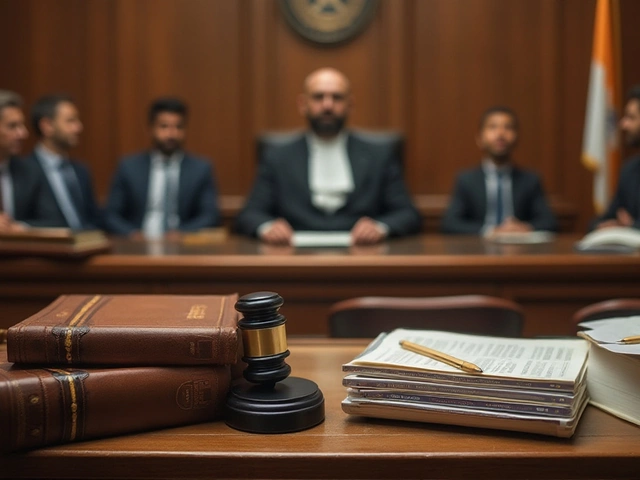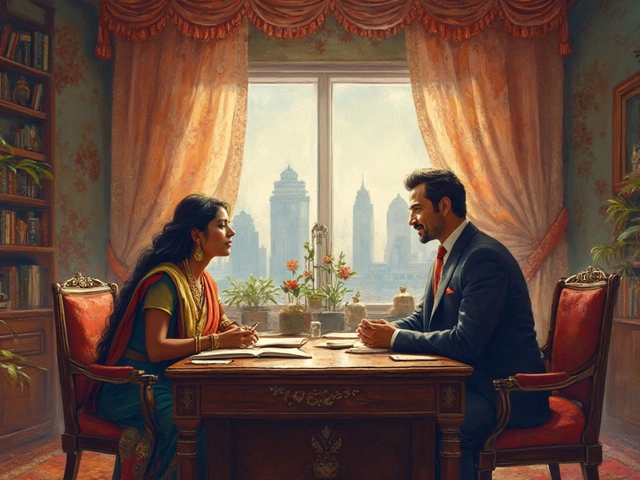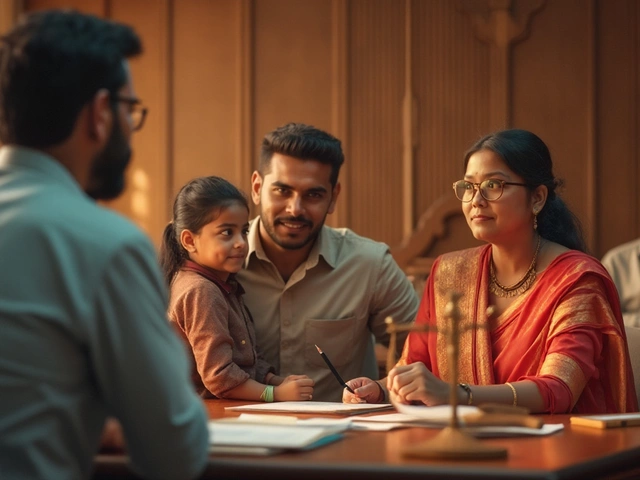You see those courtroom scenes in movies, where a bunch of people sit while lawyers ask all sorts of personal and even awkward questions? That’s voir dire in action. The phrase is French for “to speak the truth,” but in civil court, it’s jury selection, plain and simple. Both sides—lawyers for each party—get to talk to potential jurors before the trial gets going, and their goal is simple: figure out who’s going to be fair and who might lean one way or the other.
Why does this matter? Picture yourself in a lawsuit about a fender bender. Wouldn’t you want jurors who have no hidden bias against drivers your age, or people who work in your job? The wrong jury could turn a fair trial upside down. So, voir dire is more than just tradition—it’s about stacking the deck as evenly as possible.
I’ve seen folks get nervous just being picked for jury duty, let alone answering questions about their lives. But here's the thing: you’re allowed to be honest. That’s the job. Lawyers aren’t out to embarrass anyone. They want to keep things fair, so nobody gets railroaded. Even the most seasoned lawyers sometimes misread people during voir dire, which can flip the case later—no kidding, I’ve seen verdicts swing because of one overlooked answer.
- The Real Definition of 'Voir Dire'
- How Voir Dire Works in Civil Courts
- Why Voir Dire Matters More Than You Think
- Smart Tips for Handling Voir Dire
The Real Definition of 'Voir Dire'
If you ask around, most people will shrug at the term voir dire. It sounds fancy, but it just means the process of screening potential jurors before a civil trial starts. No secret handshake, no mystery—it's really just about making sure the people who end up deciding your case have no built-in bias, grudges, or weird connections to any side.
The phrase 'voir dire' comes from Old French and translates to “to speak the truth.” In the context of civil court, it’s not some high-brow ritual. It’s a down-to-earth Q&A session. Lawyers and the judge get to quiz a pool of ordinary folks about their lives, their experiences, and anything that might make them unfair—or perfect—for this particular case.
During jury selection, the judge handles the legal basics, asking everyone if they know the parties involved, have heard about the case already, or have any reason they can’t be fair. Then, each attorney gets a shot to dig a little deeper: jobs, family situations, past lawsuits, and even feelings about certain laws. Nobody escapes with just a name and address. The point? Spot red flags before someone with a loaded opinion sneaks into the jury box.
- Voir dire interviews happen out loud in open court; in rare cases, especially for sensitive topics, the judge might chat with a juror privately.
- You can’t 'fail' this process—there are no right or wrong answers. Just honest ones.
- Both lawyers have the right to strike out a limited number of jurors for almost any reason (known as 'peremptory challenges') or for cause (like a clear conflict).
Fun fact: In some U.S. states, judges do most of the questioning; in others, attorneys have more control. Some states even set strict time limits for each side. This all affects how much lawyers can learn about the people who could decide the outcome.
| Key Fact | Details |
|---|---|
| Origin | Old French, 'to speak the truth' |
| Role in civil court | Screening for unbiased jurors |
| Common topics | Work, family, legal history, opinions |
| Major goal | Fair, impartial jury |
So, the next time someone tosses around the phrase voir dire in a civil court case, you’ll know it’s just the nuts-and-bolts process of finding out who’s truly able to listen—and judge—fairly.
How Voir Dire Works in Civil Courts
The voir dire process kicks off before the civil trial even begins. The court gathers a pool of potential jurors—sometimes just a dozen, sometimes fifty or more, depending on what’s at stake. Lawyers for both sides, and sometimes the judge, ask these folks direct questions to figure out if anyone might have a hidden agenda or can’t be fair.
It’s not random chit-chat—the questions have a clear purpose. Lawyers look for anything that might sway someone’s judgment in a subtle way: past experiences, family ties, even old lawsuits. In a slip-and-fall case, they might ask, “Has anyone here worked in insurance or filed a personal injury claim?” The idea is to root out bias, even the sneaky kind people don’t realize is there.
Once the questions start, lawyers have two tools: challenges for cause and peremptory challenges. Here’s how it works:
- Challenge for Cause: If someone admits they can’t be objective—maybe they know someone in the case—they can be excused. No limits on these challenges. If it’s justified, that person is out.
- Peremptory Challenge: Each side gets a certain number of these. You can dismiss a juror for any reason (except illegal ones like race or gender). With these, no explanation is needed—but you don’t get unlimited tries, usually just two or three in a civil case.
The court goes through the potential jurors one by one until they have the needed number—often six or twelve, depending on the state. A lot of regular folks don’t know this, but both lawyers often work from lists of specific behaviors to watch for, like who’s nodding along with their opponent or giving one-word answers.
To give you a clearer picture, here’s what a typical jury selection process might look like in a civil court in the U.S.:
| Step | Description |
|---|---|
| Jury pool assembled | Potential jurors are brought in and sworn to answer honestly. |
| Questioning by judge/lawyers | Questions focus on background, beliefs, and biases relevant to the case. |
| Challenges for cause | Jurors with obvious biases or connections are excused. |
| Peremptory challenges | Each side dismisses a small number of jurors for any reason. |
| Final jury selected | Court seats the final group—trial can now begin. |
Here’s a tip if you ever find yourself in the pool: honesty is your best bet. Trying to “game” the system usually backfires—lawyers notice. If you’re excused, no worries; it’s not personal, just part of keeping the civil court process as fair as possible for everyone.

Why Voir Dire Matters More Than You Think
Most people shrug off voir dire as just a warm-up before a real trial starts, but it actually shapes the whole case outcome. In civil court, who sits on the jury can literally decide if you win or lose. You might think lawyers just swap a few polite questions, but there’s science and strategy behind every word. Seasoned trial lawyers often say that picking the right jury is half the battle—the other half is proving your story was true all along.
Here’s one wild fact: around 56% of civil trials in the U.S. flipped outcomes when jurors admitted they brought personal bias with them, but only realized it after the fact. That’s the kind of mistake voir dire tries to prevent. You don’t want conspiracy theorists or people who secretly hate insurance companies deciding your car accident claim. Civil court is about fairness, but if voir dire’s rushed or ignored, fairness goes right out the window.
Let’s break down why this process holds so much weight:
- Unearthing Hidden Bias: Lots of people don’t even know their own prejudices. Questions during voir dire are designed to gently dig those up and keep things transparent.
- Leveling the Playing Field: Both sides look for a jury that’s as neutral as possible. This helps keep trials about facts, not gut feeling or personal hang-ups.
- Strategy Game: Lawyers make quick calls about who should stay or go, often based on gut feeling backed by experience, sometimes even with help from jury consultants.
Check this out—a recent survey of attorneys showed that 8 out of 10 saw jury selection as the most critical moment in a civil case, even more than closing arguments. The wrong juror can turn a mountain of evidence into nothing.
| Voir Dire Impact | Approximate Percentage |
|---|---|
| Civil cases affected by jury bias | 56% |
| Attorneys rating voir dire as top priority | 80% |
If you’re ever called in for jury duty in a civil court case, give these questions your honest answer. You might think it’s no big deal, but truth is, the right answer at this stage can make the whole trial a lot more fair for everyone involved. On the flip side, if you’re part of a lawsuit, know that your attorney’s skills during voir dire could matter even more than you guessed.
Smart Tips for Handling Voir Dire
Walking into jury selection might make your palms sweat, but trust me, you don’t need a law degree to handle voir dire like a pro. Whether you’re a future juror, a party in the case, or just curious about civil court, here are a few tricks that not only help you get through it but maybe even help the process work better for everyone.
- Be honest from the start. This is rule one. Judges and lawyers aren’t mind readers. If you have a connection to one of the parties, a strong opinion, or even basic life experience that might make it hard to be fair, say so. Nobody can hold that against you. It’s way better to be upfront now than get called out later.
- Don’t rush your answers. Take a second to think before replying to jury selection questions. Pressure can make people blurt out stuff they don’t mean or forget something important. A calm answer can mean the difference between looking neutral and making yourself seem biased by accident.
- Listen to the questions closely. Sometimes lawyers use complex or even sneaky wording to test for hidden prejudices. If you’re confused, ask for the question again. It’s not a pop quiz. They need your real answer—especially in a civil court case where facts can get murky.
- Remember your privacy rights. There are limits. If a question feels too personal, you can ask to answer privately, often “at the bench” with just the judge and lawyers. No need to spill your life story to the whole room if you’re uncomfortable.
- Do a quick self-check before court. Think about anything in your life—work, family, past lawsuits, even social media stuff—that could come up. That way, you’re not caught off guard.
For lawyers, it’s a skill to spot who's hiding bias and who’s unaware. Some attorneys keep running tabs on how jurors answer. In fact, a 2023 survey by the National Center for State Courts found that about 38% of civil lawyers use software to track what jurors say and how they say it during voir dire. Take a look at how some strategies compare:
| Common Voir Dire Tactics | Used By % of Lawyers |
|---|---|
| Preparing specific question lists | 81% |
| Watching for body language | 67% |
| Background checks on social media | 56% |
| Using jury selection software | 38% |
Even if you’re the one facing the court, talk with your lawyer about your answers and any concerns. Sometimes it’s the little details—like if your uncle once sued someone or you follow a certain advocacy group online—that make all the difference in a court process like this. There’s no perfect formula, but honest, steady answers go a long way toward making things fair for everyone.


